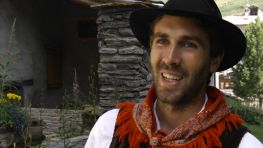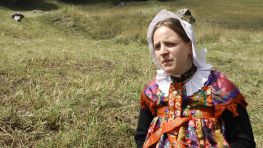 Vincent Bernard Roulph
Vincent Bernard Roulph Defoliating the carnivalesque bear
Documentary
Video table of contents
Interview information
Country: IT
Region: Piemonte
City: Cunico
District: AT
Altitude: 256m s.l.m.
Wikipedia: http://it.wikipedia.org/wiki/Cunico
Attached images:
Bibliography:
Artoni A. (1996), Il teatro degli Zanni. Rapsodie dell’arte e dintorni, Costa & Nolan, Milano.
Bonato L. (2003), “L'orso di Villaro d'Acceglio”, in Grimaldi P. (a cura di), Bestie, santi, divinità. Maschere
animali dell'Europa tradizionale, Museo nazionale della montagna, Torino.
Bonato L. (2006), Tutti in festa. Antropologia della cerimonialità, FrancoAngeli, Milano.
Bravo G.L. (2005a), Feste, masche, contadini: racconto storico-etnografico sul Basso Piemonte, Carocci,
Roma.
Bravo G.L. (2005b), La complessità della tradizione. Festa, museo e ricerca antropologica, FrancoAngeli,
Milano.
Canclini N.G. (1989), Culturas hibridas. Estrategias para entrar y salir de la modernidad, Grijalbo, Mèxico,
trad. it Culture ibride. Strategie per entrare e uscire dalla modernità, Guerini, Milano, 1998.
Carénini A. (2003), “Animali per smascherare”, in Grimaldi P. (a cura di), Bestie, santi, divinità. Maschere
animali dell'Europa tradizionale, Museo nazionale della montagna, Torino.
Frazer J.G. (1890), The Golden Bough, Mcmillan, London, trad it. Il ramo d’oro, Boringhieri, Torino, 1965.
Gallino L. (1980), La società: perché cambia, come funziona, Paravia, Torino.
Grimaldi P. (1993), Il calendario rituale contadino, FrancoAngeli, Milano.
Grimaldi P. (1996), Tempi grassi, tempi magri: percorsi etnografici, Omega, Torino.
Grimaldi P. (2000), “Orso pagano, orso cristiano”, Introduzione a Orsi D., La Passione di Sordevolo, Studio
di drammatica popolare, Omega, Torino.
Grimaldi P. (a cura di) (2003), Bestie, santi, divinità. Maschere animali dell'Europa tradizionale, Museo
nazionale della montagna, Torino.
Grimaldi P., Nattino L. (2007), Dei Selvatici, Regione Piemonte, Museo Regionale di Scienze Naturali di
Torino, Torino.
Lajoux D. (1996), L’homme et l’ours, Glenat, Grenoble.
Lajoux D. (2003), “Maschere animali e cortei mascherati d'inverno”, in Grimaldi P. (a cura di), Bestie, santi,
divinità. Maschere animali dell'Europa tradizionale, Museo nazionale della montagna, Torino.
Orsi D. (2000, ed.or. 1892), La Passione di Sordevolo, Studio di drammatica popolare, Omega, Torino.
Toschi P. (1999, ed. or. 1955), Le origini del teatro italiano, Boringhieri, Torino.
Sitography:
http://www.casadeglialfieri.it
Document by: Andrea Icardi
Video by: Luciano Nattino, Pier Carlo Grimaldi
Created: 21-03-2006







